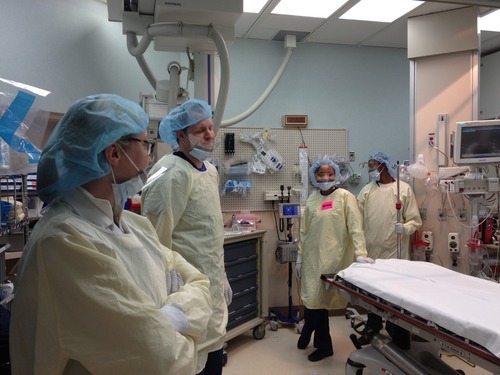In my last post, I presented the issue of dealing with a surprise patient who was both in arrest and contaminated with gasoline. They are brought into your resuscitation room without warning of the potential hazard. Now that they are here, what do you do?
Thanks for the many online and email responses. This is a tough question, because there are so many variables to think about. And you have to make decisions very quickly. Here’s a rundown on my thought processes.
First, if you get an indication that there might be any type of contamination, insist that your prehospital providers hold the patient outside the ED. Have part of your trauma team waiting at the ambulance dock to do a quick assessment there. Another minute or two of Lucas CPR will not make a difference. Use your best judgment as to how much of a hazard is posed by the fuel/mystery liquid/white powder. But err on the side of being conservative so you don’t end up shutting your entire ED down due to contamination. If in doubt, immediately move to your decontamination area.
If the patient ends up deep in your ED before anyone recognizes that there might be a contamination problem, you must heed three overarching principles:
- Limit contamination to the rest of your facility. Close the doors to the resuscitation room. Notify security and your hazardous materials team so they can start working on containment and safety issues outside the room. Failure to do this can take your entire hospital offline. If the situation turns out to be a multiple or mass casualty event and your hospital was the only one able to respond, you’ve just created a catastrophe and delayed treatment for the other patients.
- Ensure the safety of your team. This is a great reason to require and enforce that everyone on the team dress up completely for every resuscitation. You never know where your patients have been, and when one of these will sneak in.
- Continuously assess the risk:benefit ratio. Is the contamination a minor irritant? What is the danger to the team? The ED/hospital? How likely are your efforts to save the patient to succeed? As soon as the ratio goes bad, rethink the options and act accordingly.

Bottom line: In situations like this, think fast and think globally. Don’t just consider the patient. There may be many more lives at stake, and this can and should factor into your decisions about where and how long to continue resuscitation.
In this case, we were certain it was only gasoline. We closed the doors and quickly stripped the patient, bagging the clothes tightly. We tried not to generate any sparks, but we are surrounded by all kinds of electrical equipment. Defibrillation was out of the question. After the event was finished, it was time to wash everything down and start thinking about what would have happened if this had been something more toxic than fuel!
Related post:

